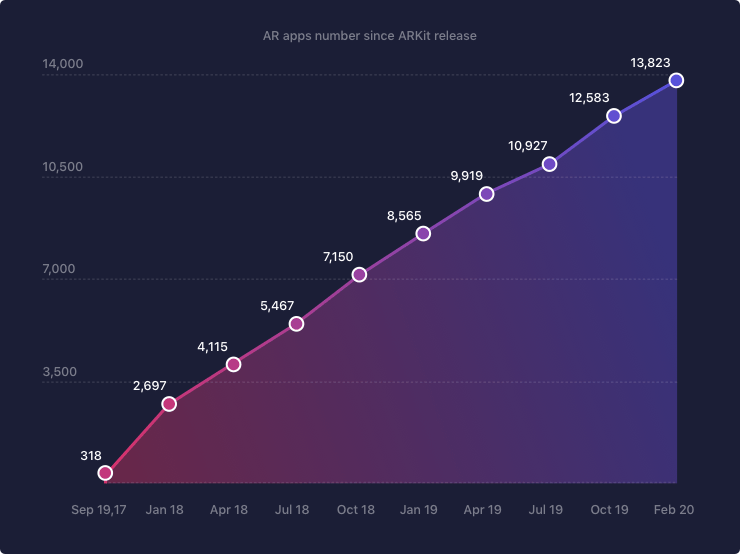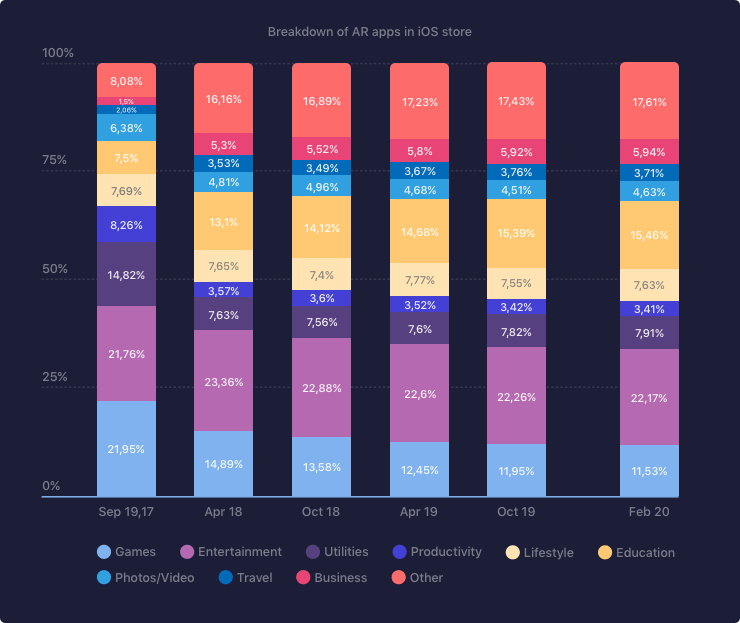AR on iOS before ARKit
With the initial App Store release, there were eight AR apps. In the next nine years, the total number of apps in the iOS store reached 17,204. More than 6,000 of them are still available, more than 3,000 were updated since the initial ARKit release, and more than 1,500 were updated in 2019.
ARKit Era

Reportedly, on the release day, there were approximately 300 apps using ARKit. More than one fifth of them (21.95%) were games, almost the same number (21.76%) fell into the entertainment category, and almost 14.82% were utilities, while categories like Finance, Medical, News and Weather were the least popular among AR apps, with each of these categories having one AR app.
During the first three months of ARKit, over 2,000 new AR apps appeared in the App Store, with the number of AR apps growing gradually since then. Every month, developers were adding, on average, 470 AR apps, which makes up 1.2% of all apps released monthly (approximately 40,000). On February 1, 2020, the total number of AR apps released since the ARKit launch reached 13,829 (11,192 of them are currently available in the App Store).
Category Breakdown

Once a year, Apple updates ARKit, making it more advanced and usable in different areas. So, even though the number of apps in each category was constantly growing, and the top nine categories remained the same, the percentage of AR apps in some categories has changed. This trend suggests that AR ceases to be just entertainment, making augmented reality a compulsory modern function that significantly improves the user experience.
Thus, the Games category has fallen from 22% on the initial release day to only 11.5% after two years, while the percentage of AR apps in categories like Travel and Education doubled from 2% and 7.5% to 4% and 15%, respectively. The number of AR apps in the Business category has multiplied by 4 and has risen from only 1.5% in 2017 to 6% in February 2020. The percent of new AR apps in the Entertainment and Lifestyle categories remains relatively even. The number of AR apps in other categories doubled during these two years, reaching 17.6% in February 2020.
Summary
Even though AR technology is still in the early stages of development, and everyone is anticipating how the upcoming Apple AR glasses will shape the market, it has already made a huge leap forward and found usage far beyond the Gaming and Entertainment sectors. The most prominent examples of ARKit integration in non-gaming apps use AR to: show the future house or interior in the real-world environment before you build it and how the furniture will look in your room before you purchase it; let you virtually “try on” makeup items before you order them; and bring 3D anatomy into the real world, exploring and virtually dissecting the model in real-time.
